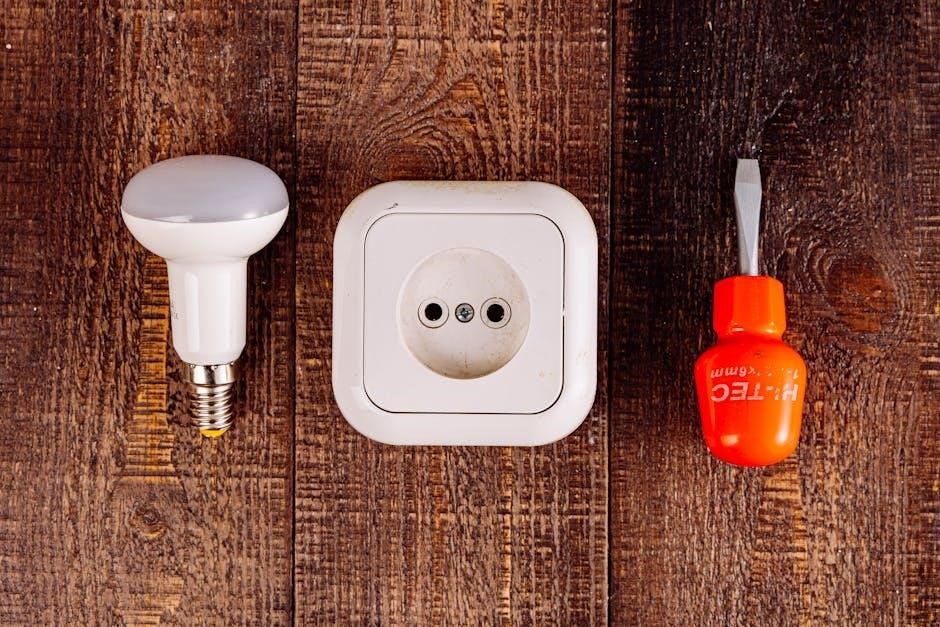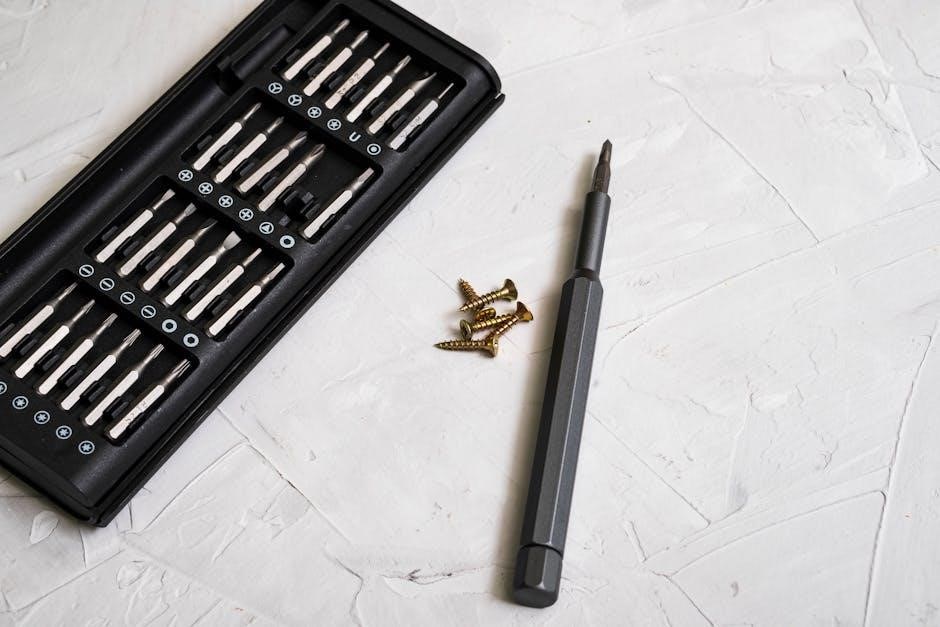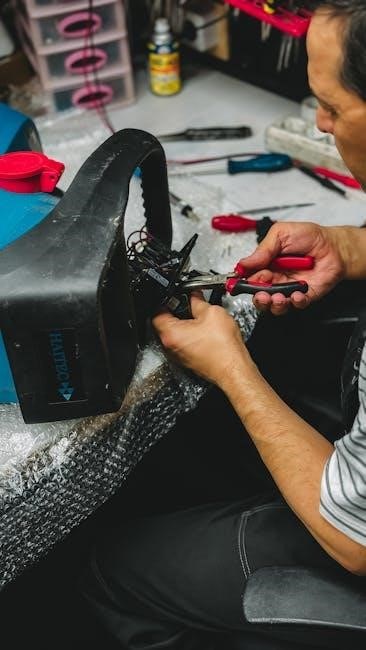Overview of the Singer 500a Manual
The Singer 500a manual is a comprehensive guide for operating and maintaining the sewing machine, covering setup, features, and troubleshooting. It ensures optimal performance and longevity.
1.1 Importance of the Manual for Sewing Machine Operation
The Singer 500a manual is essential for understanding the machine’s features, proper operation, and maintenance. It provides detailed guidance on setup, troubleshooting, and customization, ensuring users can maximize the machine’s capabilities. The manual serves as a troubleshooting guide, helping users identify and resolve common issues, such as poor stitching or mechanical problems. By following the manual’s instructions, users can maintain the machine’s performance and extend its lifespan. Additionally, it offers insights into the machine’s advanced features, like special stitches and the SLANT-O-MATIC design, allowing users to explore creative possibilities. Accessing the manual is straightforward, with options to download PDF versions from trusted sources like the Sewing Dude Blog. This resource is vital for both new and experienced users, ensuring optimal use and satisfaction.

Where to Download the Singer 500a Manual
The Singer 500a manual can be downloaded from Singer’s official website, Sewing Dude Blog, or trusted sewing parts stores. Free PDF versions are widely available online.
2.1 Official Sources and Trusted Websites
The Singer 500a manual can be downloaded from the official Singer website, ensuring authenticity and reliability. Trusted sources like Sewing Dude Blog and sewing parts stores also offer free PDF versions. These websites provide comprehensive guides, including setup, maintenance, and troubleshooting instructions. The manuals are often available in full-size, clean formats without imperfections, making them ideal for users. Official sources guarantee that the content is accurate and tailored specifically for the Singer 500a model. Additionally, these platforms frequently update their resources, ensuring users have access to the most current information. Downloading from trusted sites minimizes the risk of outdated or incorrect instructions, providing a seamless experience for sewing machine operation and maintenance.
2.2 Free PDF Downloads and Instructions
Free PDF downloads of the Singer 500a manual are readily available online, offering detailed guidance for users. Websites like the Sewing Dude Blog and trusted sewing communities provide instant access to these manuals. The PDFs are often full-size and clean, ensuring clarity and ease of use. Many downloads include comprehensive instructions for setup, maintenance, and troubleshooting. Some versions are specifically marked as “Not for resale,” emphasizing their free availability for personal use. These manuals cover everything from basic operation to advanced features, making them invaluable for both beginners and experienced sewists. Additionally, large-format deluxe editions are available for those who prefer higher-quality documentation. Downloading these manuals is straightforward, with most sites offering direct links or simple right-click options to save the files.

Key Features of the Singer 500a Sewing Machine
The Singer 500a features advanced stitching options, customizable settings, and the innovative SLANT-O-MATIC design, enhancing sewing precision and versatility for a wide range of projects.
3.1 Special Stitches and Customization Options
The Singer 500a sewing machine offers an extensive range of special stitches, including decorative, utility, and stretch stitches, catering to diverse sewing needs. Users can customize stitch length, width, and tension for precise control. The machine also features adjustable settings for various fabric types, ensuring optimal results. Additionally, the SLANT-O-MATIC design allows for better visibility and smoother fabric flow, enhancing the sewing experience. Advanced customization options enable users to tailor settings to their specific projects, making the Singer 500a versatile for both basic and intricate sewing tasks. This feature-rich design makes it a preferred choice for sewists seeking creativity and precision in their work.
3.2 SLANT-O-MATIC Design and Its Benefits
The Singer 500a features the innovative SLANT-O-MATIC design, which provides an angled sewing surface for improved visibility and control. This unique feature allows users to see the needle and fabric more clearly, making it easier to manage intricate stitches and align materials accurately. The slant design also enhances fabric flow, reducing bunching and ensuring smooth operation.
The SLANT-O-MATIC design contributes to a more comfortable sewing experience by minimizing eye strain and improving precision. It is particularly beneficial for sewing delicate or layered fabrics, as it maintains consistent tension and prevents slippage. This design element is a key factor in the machine’s reputation for durability and ease of use, making it a standout choice for both beginners and experienced sewists.

Maintenance and Troubleshooting

Regular maintenance and troubleshooting are crucial for optimal performance. The manual provides clear instructions and practical advice for common issues like thread jams and motor problems. Following these guidelines ensures smooth operation and extends the machine’s longevity.
4.1 Oiling and Cleaning the Machine
Regular oiling and cleaning are essential for maintaining the Singer 500a’s performance. Apply a few drops of recommended oil, such as Tri-Flow, to the gears and moving parts. Open the side panel and top cover to access these areas. Use a soft brush to remove lint and debris from the bobbin case, feed dogs, and tension discs. Avoid using harsh chemicals or excessive force, which could damage the machine. Clean the exterior with a damp cloth to keep it dust-free. Proper maintenance ensures smooth operation, prevents rust, and extends the machine’s lifespan. Follow the manual’s specific instructions for oiling intervals and cleaning techniques to keep your Singer 500a in optimal condition.
4.2 Common Issues and Solutions
Common issues with the Singer 500a often relate to thread tension, needle breakage, or stitch irregularities. If thread bunches underneath fabric, check and adjust the bobbin tension or ensure the needle is properly threaded; Needle breakage can occur due to incorrect needle size or type; always use Singer-compatible needles. For jammed stitches, clean lint from the bobbin area and feed dogs. If the machine skips stitches, inspect the needle for damage or replace it. Lubrication issues may cause noisy operation; apply Tri-Flow oil as directed. Consult the manual for specific troubleshooting steps or diagrams. Regular maintenance and proper thread setup can prevent many of these issues, ensuring smooth operation and consistent stitching quality.

Professional Service Manual for Singer 500a
The Singer 500a Professional Service Manual offers a detailed guide for advanced users, covering comprehensive maintenance, troubleshooting, and repair procedures for models 500, 500a, 503, and 503a.
5.1 Comprehensive Guide for Advanced Users

The Singer 500a Professional Service Manual is a detailed guide tailored for advanced users, offering in-depth insights into maintenance, troubleshooting, and repair procedures. It covers models 500, 500a, 503, and 503a, ensuring comprehensive coverage for technicians and experienced sewists. The manual includes intricate diagrams, parts lists, and step-by-step instructions for complex repairs. With over 100 pages, it provides advanced techniques for optimizing machine performance and addressing technical issues. This resource is ideal for professionals seeking to service or restore their Singer 500a sewing machine to its original functionality. It emphasizes precise methods for maintaining and upgrading the machine, ensuring longevity and peak performance.

Additional Resources and Guides
Explore additional resources like the Sewing Dude Blog and other sewing communities, including forums and user discussions, for troubleshooting tips, repair guides, and maintenance advice tailored for the Singer 500a.
6.1 Sewing Dude Blog and Other Helpful Links
The Sewing Dude Blog is a valuable resource for Singer 500a users, offering detailed guides, troubleshooting tips, and maintenance advice. It provides free PDF downloads of the manual, ensuring easy access to instructions. The blog also features user discussions and community support, making it a go-to for resolving common issues. Additionally, the blog highlights the importance of proper setup and customization options. For advanced users, it references a professional service manual. Links to trusted sources like Singer’s official website are also available, ensuring authenticity. This comprehensive resource helps users optimize their sewing experience, making it an essential companion for both beginners and experienced sewists.





























































